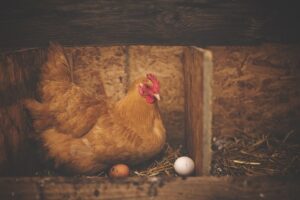When you picture the life of a contented chicken, your mind may drift to sunny garden scenes and pecking in the grass – a picturesque life deemed idyllic for our feathered friends. However, a lesser-known key to your chicken’s overall health and happiness isn’t just in the quality of their feed or the spaciousness of their coop. Chicken grit – quite literally – can make or break their well-being.
Unveiling Grit and Its Crucial Place in the Chicken’s Digestive Journey
In the sprawling tapestry of a chicken’s dietary requirements, ‘grit’ forms an indispensable thread. For the uninitiated, grit refers to small, hard particles that chickens (and other birds) consume to aid in the processing of their food. Grit comes in two distinct types with complementary roles, offering a more nuanced perspective on a chicken’s dietary needs and, subsequently, its health.
Understanding Insoluble Grit and Its Mechanisms
Insoluble grit, despite its minuscule presence, is a heavyweight contributor to a chicken’s health. Comprised of pebbles, flint, and crushed granite, insoluble grit serves as the gizzard’s partner in breaking down food. The gizzard, a muscular organ, contracts and grinds food with the help of these tiny rock-like structures, facilitating better digestion.
The Vitality of Soluble Grit for Essential Nutrient Upkeep
On the other hand, soluble grit, derived from sources like oyster shells, limestone, and crushed seashells, is a trove of calcium. This mineral is pivotal for the good health of a laying chicken, as it aids in the strength and formation of eggshells, ensuring the vitality of future broods.
The Digestive Symphony: Role of Grit in Chicken Health
The digestive health of a chicken is a multifaceted domain that can be considerably bolstered by a conscientious inclusion of grit in their diet. It’s not just about preventing minor ailments; grit has far-reaching benefits that support the very foundation of a chicken’s life – its gut health.
Enhancing Digestive Efficiency
Grit grinds down feed items, augmenting the mechanical breakdown process, ultimately enhancing the efficiency of nutrient absorption. This could mean the difference between a well-fed, plump hen and one suffering from malnutrition due to poor digestion.
Improved Nutritional Absorption
Soluble grit, particularly essential in laying hens, is directly linked to calcium absorption, ensuring that the nutritional needs are met for the arduous task of egg-laying and nurturing future generations.
Holistic Health Benefits
Grit serves as a guardian against potential digestive blockages, a peril that not only spells discomfort for your chicken but can also be life-threatening. Additionally, the improved nutrient utilization sets the stage for overall health and vitality; a chicken that’s digesting well is a chicken that’s thriving.
How to Serve Grit Right: Incorporating It Into the Chicken Diet
Understanding the why is just the beginning. The how and when of grit supplementation are where the fine details of avian nutrition come into play. Implementing the right grit regimen is essential for the overall efficacy of such a supplement.
Free-Range vs. Coop-Raised Chickens
For free-range chickens, nature typically provides an assortment of grit in the form of gravel and other pebbles. However, for coop-raised birds, an external source of grit becomes essential.
Recommended Grit Size
The appropriate size of grit is crucial and varies based on the age and size of the hens. Younger chickens require smaller, more manageable grit particles, while older, larger hens can handle coarser grains.
Frequency and Amount
It’s a delicate balance – too little grit, and you risk nutrient deficiencies and digestive issues; too much, and you might compromise the intake of essential nutrients from their regular feed. This section dives into detailed recommendations for your flock size and age, ensuring a harmonious integration of grit in their daily diet.
Navigating Grit Challenges With Finesse
No dietary shift is without its hiccups, and introducing grit to your chickens’ diet can be met with resistance or mishaps. Identifying and addressing these obstacles is an essential part of the process, ensuring that the intended benefits of grit supplementation are fully reaped.
Balancing Insoluble and Soluble Grit
Just as the dieter’s mantra goes – balance is key. Grit is no different; an optimal blend of the two types must be calibrated according to your chicken’s specific needs and diet. This chapter provides hands-on tips for achieving this equilibrium.
Overcoming Common Obstacles
Resistance to changes in feed is not uncommon, and chickens can be notoriously picky eaters. Additionally, the selection of the right grit source and the logistics of providing it can present challenges. Here, we explore practical solutions and troubleshooting for a seamless grit integration.
The Role of Chicken Grit in Livestock and Poultry Management
Beyond the individual pieces of advice lies a larger framework of poultry management. How you incorporate chicken grit into your chicken’s life speaks to your understanding of their needs and your commitment to their welfare. It is a testament to the management system you’ve designed for your flock, one that values consideration of every aspect that impacts their health and productivity.
Conclusion: Grit as the Unsung Champion of Chicken Health
In the holistic approach to chicken health, grit may not be the star of the show, but it is undoubtedly the unsung hero. This minuscule component of a chicken’s diet holds the power to transform their well-being, from enabling smoother digestion to supporting robust health and prolific egg production. For the chicken enthusiast, homesteader, or amateur poultry keeper, the inclusion of grit isn’t just a dietary detail; it’s a practice that underscores a commitment to the comprehensive welfare of these cherished birds.
By recognizing the integral role of grit in a balanced diet, you’re not just providing for your chickens; you’re sustaining a cycle of health that encompasses all facets of their existence, from producing nutrient-rich eggs to preserving their own vigor. Your chickens may never thank you for this gritty intervention, but in their chirps and clucks, you’ll find the telltale sign of contentment – and that’s the most rewarding acknowledgment of all.
Check out my other chicken care articles:
Chicken Foraging and Free Ranging
Best Chicken Breeds for Egg Laying

